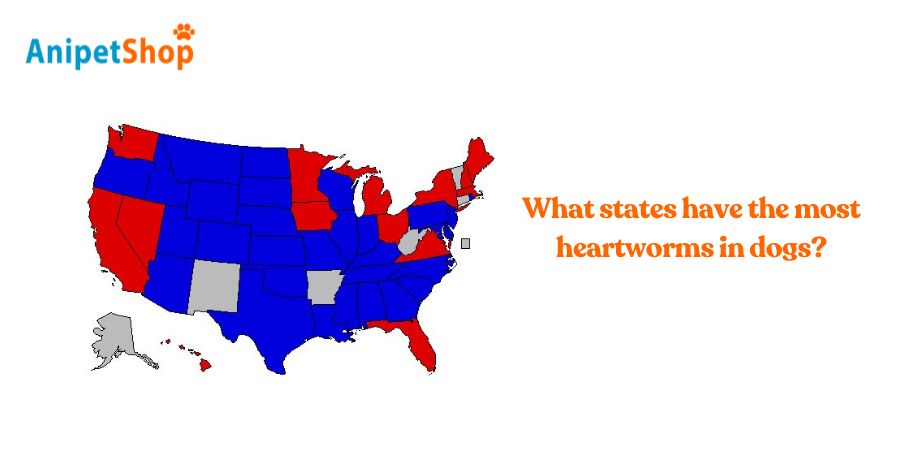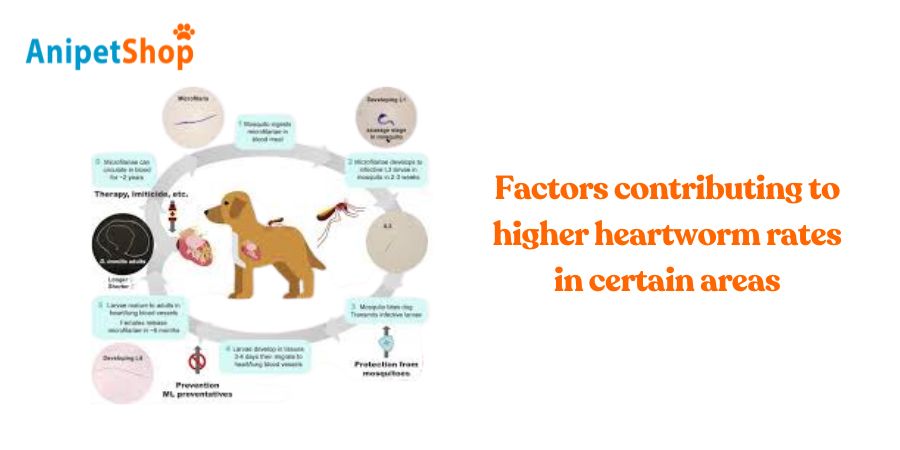The State of Heartworm Incidence in the United States
Heartworm cases are on the rise in states like Mississippi, Louisiana, Arkansas, Texas, and Tennessee. These regions, with their warm and humid climates, are prime breeding grounds for mosquitoes, the main transmitters of heartworm larvae.
The southeast, especially the lower Mississippi Delta, reports the highest cases. Areas along the Gulf Coast and Atlantic Seaboard also see significant numbers. As heartworm cases increase nationwide, it’s crucial to understand why some areas are more affected and how to protect your pets.
So, why are some areas more affected than others?

What states have the most heartworms in dogs?

In recent years, Mississippi, Louisiana, Arkansas, Texas, and Tennessee have reported the highest heartworm incidence in dogs. These states have warm, humid climates ideal for mosquitoes, the carriers of heartworm larvae.
The abundance of mosquitoes in these environments increases the risk of dogs contracting heartworms through bites. Mississippi tops the list due to its high temperatures and numerous wetlands, perfect breeding grounds for mosquitoes.
Louisiana follows closely with its swamps and humid weather, creating another mosquito haven. Arkansas and Texas also have warm climates and large rural areas where accessing veterinary care might be harder, complicating prevention. Tennessee, though slightly cooler, still supports mosquito populations, especially in its river valleys.
Studies, such as the 2019 American Heartworm Society survey, confirm these findings, showing these states report the highest number of cases annually. Understanding why these regions are hotspots highlights the importance of preventive measures and regular heartworm testing for dogs in these areas.
Geographic distribution of heartworm cases across the United States
Heartworm disease affects dogs across the United States, but it’s most prevalent in the southeastern region, particularly in the lower Mississippi Delta. States like Louisiana, Mississippi, and Alabama, with their warm and humid climates, provide perfect breeding grounds for mosquitoes—the primary carriers of heartworm larvae. These conditions lead to higher heartworm rates compared to other areas.
However, no state is entirely safe from heartworm. States along the Gulf Coast and the Atlantic Seaboard, such as Texas and Florida, also report significant numbers of cases each year, highlighting the disease’s widespread nature.
As you move north and west, heartworm cases become less common but don’t disappear. The Midwest and even parts of the Northeast still see infections, albeit at lower rates. This nationwide distribution underscores the need for vigilance and preventive measures everywhere.
While your dog’s risk may be higher in certain regions, heartworm prevention is crucial no matter where you live.
Trends in heartworm prevalence over time

Over recent years, heartworm cases have surged across the United States, signaling a troubling trend in pet health. Data from the American Heartworm Society (AHS) shows a steady rise in heartworm prevalence. For instance, their 2019 survey revealed a 21% increase in heartworm-positive dogs per clinic compared to 2016. This alarming trend spans states from high-risk areas like the Southeast to regions once considered lower risk.
Annual reports and studies from veterinary organizations highlight this upward trend. In 2021, the AHS documented significant increases in heartworm incidence in states such as California, Illinois, and Pennsylvania. These findings align with earlier reports, which show a year-over-year increase in heartworm cases, underscoring the persistent and growing threat.
Despite advances in prevention and treatment, the rise in heartworm prevalence continues. This trend emphasizes the necessity of regular testing and preventive measures to protect pet health.
Staying informed and proactive can help combat this increasing threat and safeguard pets from heartworm disease.
Factors contributing to higher heartworm rates in certain areas

Several factors contribute to the higher heartworm rates in specific areas of the United States. Warm climates are a primary factor. Heartworms thrive in regions with elevated temperatures because their larvae need warmth to mature inside mosquito vectors. States like Florida and Texas, known for their hot and humid conditions, often report higher incidences of heartworm.
Additionally, standing water in urban and rural areas provides ideal breeding grounds for mosquitoes. Areas with heavy rainfall or poor drainage systems are particularly vulnerable. In a 2018 study by the American Heartworm Society, regions with frequent flooding saw a spike in heartworm cases.
Another factor is pet movement. When pets travel from high-incidence areas to regions with lower rates, they can spread the disease. This is especially true during natural disasters when pets may be relocated en masse.
Lastly, socioeconomic factors play a role. Areas with limited access to veterinary care often see higher rates of heartworm infection. Pet owners in these regions may lack resources for preventative medications, making their pets more vulnerable.
Addressing these factors is essential for controlling heartworm spread.
Conclusion
Heartworm incidence is highest in states like Mississippi, Louisiana, and Texas. Warm, humid conditions in these areas favor mosquitoes.
The southeastern region, including the Mississippi Delta, sees the most cases. Significant numbers are also found along the Gulf Coast and Atlantic Seaboard.
Given the increasing prevalence nationwide, prioritize regular testing and preventative measures to protect your pets.
Don’t delay—take action now to safeguard their health and well-being.
Lily Watson is an author specializing in veterinary care in Australia. With a profound passion for animal welfare and a solid foundation in veterinary science, Lily has dedicated herself to disseminating valuable knowledge and information for both pet owners and professionals in this field.

